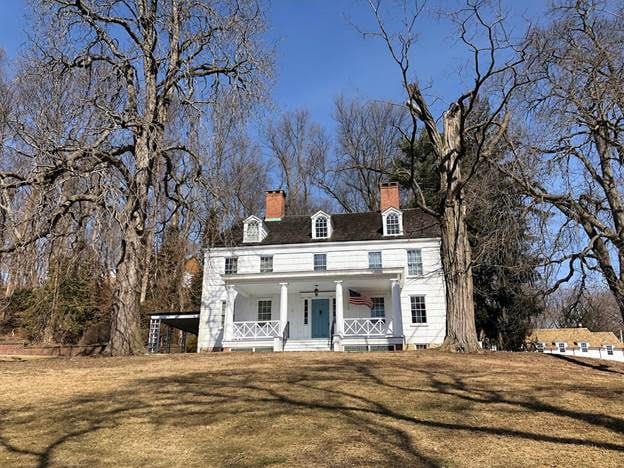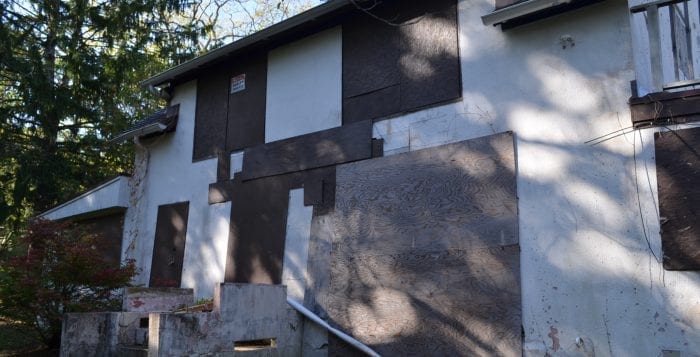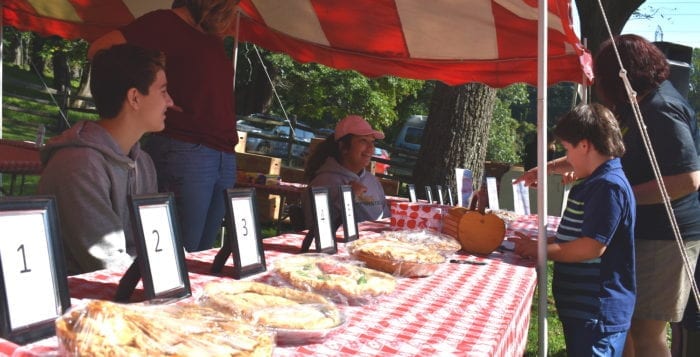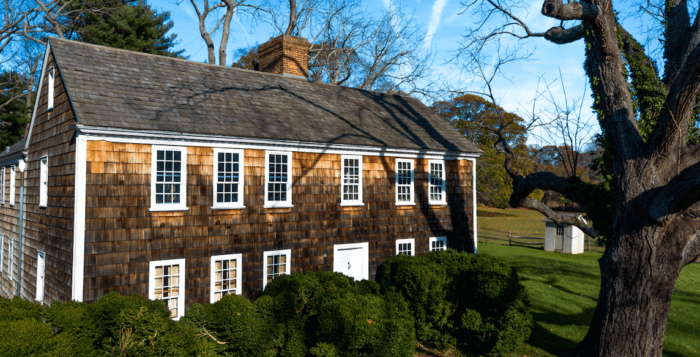- A live panel discussion moderated by Darren St. George, Director, Education & Public Programs, Preservation Long Island featuring Jonathan Olly, Curator of The Long Island Museum, Mark Chambers, Visiting Assistant Professor of Africana Studies at SUNY Stony Brook, and Lynda Day, Professor of Africana Studies, Brooklyn College-CUNY.
- The new publication and discussion on the ways historians, museums, and professors are working to make Long Island’s past more accessible.
- Current approaches to teaching Black history, as well as how conversations around Northern (and specifically Long Island) slavery has changed over the last few decades will be examined.
Preservation Long Island
Preservation Long Island awarded Gardiner grant
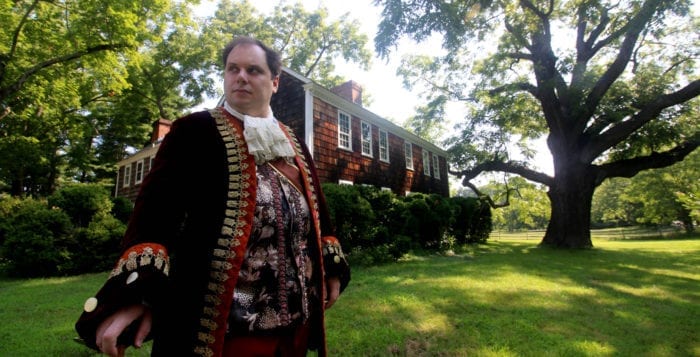
Preservation Long Island, a regional preservation advocacy group, was awarded a $2,000 reimbursement grant from the Robert David Lion Gardiner Foundation. The announcement was made in a press release on Jan. 28. The grant has helped Preservation Long Island to preserve valuable operating funds and redirect a portion of funding towards improving online programming capacity.
“We are so grateful for the continued support from the Gardiner Foundation, especially during this challenging time”, said Alexandra Wolfe, Executive Director of Preservation Long Island. “In light of the pandemic, Preservation Long Island, like most of its institutional colleagues, has had to swiftly transition to online platforms to implement our educational and advocacy programs. Relief funds from the Gardiner Foundation have supported technology upgrades and the purchase of video production equipment to improve the quality of programs that have been reformatted for online engagement and feature prominently at our website and Vimeo channel”.
Preservation Long Island initiatives with expanded virtual offerings and enhanced online components include the Jupiter Hammon Project (which now incorporates a growing collection of virtual discussions about salient topics related to the study of enslavement in the north); “Historian’s Stories” where town historians present local history; virtual exhibitions and events with regional partner organizations; and tutorial presentations to help communities and individuals navigate our many preservation advocacy tools including the new Local Landmark Law Locator that provides an easy way to explore local landmark laws in our region.
“The Robert David Lion Gardiner Foundation hopes that these funds will alleviate at least a small part of Preservation Long Island’s financial burden during these extraordinary times,” said Kathryn M. Curran, Executive Director of the Robert David Lion Gardiner Foundation.
Preservation Long Island maintains and interprets historic sites and collections that embody various aspects of Long Island’s history including:
Joseph Lloyd Manor, Lloyd Harbor http://preservationlongisland.org/joseph-lloyd-manor/
Custom House, Sag Harbor http://preservationlongisland.org/custom-house/
Sherwood-Jayne Farm, Setauket http://preservationlongisland.org/sherwood-jayne-farm/
Old Methodist Church and Exhibition Gallery http://preservationlongisland.org/methodist-church/
For more information, visit www.preservationlongisland.org.
TVHS and Tri-Spy Tours presents a virtual Culper Spy Day this weekend
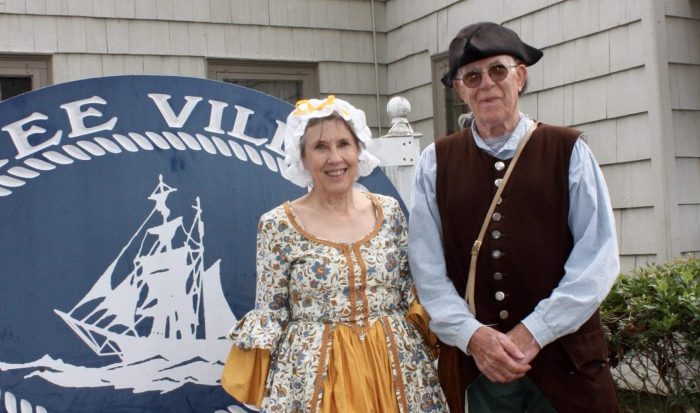
Margo Arceri first heard about George Washington’s Setauket spies from her Strong’s Neck neighbor and local historian, Kate W. Strong, in the early 1970s. Arceri lights up when talking about her favorite spy, Anna Smith Strong.
“Kate W. Strong, Anna Smith Strong’s great-great-granddaughter, originally told me about the Culper Spy Ring when I used to visit her with my neighbor and Strong descendant Raymond Brewster Strong III. One of her stories was about Nancy (Anna Smith Strong’s nickname) and her magic clothesline. My love of history grew from there,” she said.
Seven years ago Arceri approached the Three Village Historical Society’s President Steve Hintze and the board about conducting walking, biking and kayaking tours while sharing her knowledge of George Washington’s Long Island intelligence during the American Revolution.
Today, Arceri runs Tri-Spy Tours in the Three Village area, which follows in the actual footsteps of the Culper Spy Ring. “I wanted to target that 20- to 60-year-old active person,” she said. “I have to thank AMC’s miniseries ‘Turn’ because 80 percent of the people who sign up for the tour do so because of that show,” she laughs.
It was during one of those tours that Arceri came up with the idea of having a Culper Spy Day, a day to honor the members of Long Island’s brave Patriot spy ring who helped change the course of history and helped Washington win the Revolutionary War.
“Visiting places like the Brewster House, which is owned by The Ward Melville Heritage Organization, the grave site of genre artist William Sidney Mount at the Setauket Presbyterian Church cemetery (whose paintings are at The Long Island Museum) and the Country House, which was built in the 1700s,” Arceri thought “there has to be a day designated to celebrating all these organizations in the Three Villages and surrounding areas; where each of us can give our little piece of the story and that’s how Culper Spy Day developed.”
After a successful five-year run, plans were underway for the sixth annual Culper Spy Day when the pandemic hit. At first the event was canceled out an abundance of caution but now has been reinvented and will be presented virtually on Facebook Live on Sept. 12 and 13 to be enjoyed from the comfort of your home.
The Three Village area is full of hidden intrigue and stories of how America’s first spy ring came together secretly to provide General George Washington the information he needed to turn the tide of the American Revolution.
Over the course of the weekend, you will have the chance to visit many of the cultural organizations from years past who will share their story, including the Three Village Historical Society, Tri-Spy Tours, Ward Melville Heritage Organization, Special Collections and University Archives at Stony Brook University, Preservation Long Island, Emma S. Clark Memorial Library, Drowned Meadow Cottage, Caroline Church of Brookhaven, Ketcham Inn Foundation and more in a virtual format.
■ Join Margo Arceri from Tri-Spy Tours live from the Village Green on Saturday at 9 a.m.
■ Meet Big Bill the Tory live at the Sherwood-Jayne House.
■ Take a Virtual Spies! exhibit tour with TVHS historian Bev Tyler.
■ Visit the famous Brewster House with Ward Melville Heritage Organization Education Director Deborah Boudreau.
■ View a resource guide to everything Culper Spy Day courtesy of Emma Clark Library.
■ Watch a short film on Long Island’s South Shore from the Ketcham Inn Foundation.
■ Make your very own periscope with Gallery North.
■ Read up on the Revolutionary War History from the Caroline Church of Brookhaven.
■ Look back at the festivities from 2016 Culper Spy Day.
■ Don’t miss the five part virtual spy tour series with historian Bev Tyler.
■ Listen to the lecture “Spies in the Archive: A history of two George Washington Culper Spy Ring letters presented by Kristen Nyitray Special Collections, Stony Brook University Libraries.
■ Learn about SBU’s two Culper Spy Ring letters and access images and transcripts Special Collections, Stony Brook University Libraries
■ Dive into George Washington & the Culper Spy Ring A comprehensive research and study guide Special Collections, Stony Brook University Libraries
■ Find out who Agent 355 was from historian Bev Tyler.
■ Listen to the story of Nancy’s Magic Clothesline, written by Kate Wheeler Strong, and told by Margo Arceri.
No registration is necessary. For more information, visit www.tvhs.org/virtualculperday.
Preservation Long Island to launch virtual exhibition
Preservation Long Island will launch a new virtual exhibition, Indigenous History & Art at Good Little Water Place, beginning Sept. 3. Artwork from nine contemporary Indigenous artists centers the exhibit. Offering an inquisitive look at the history and on-going relations between Indigenous people and land, the show reminds viewers of a shared responsibility to recognize our common histories and know how they impact our connections to place.
Organized by Preservation Long Island with guest curators, Jeremy Dennis, artist and a tribal member of the Shinnecock Indian Nation in Southampton, and Dr. Gwendolyn Saul, Curator of Ethnography, New York State Museum, the exhibition features objects from the collections of Preservation Long Island, the New York State Museum, and the Southold Indian Museum.
“We are thrilled this important exhibition, that began as a collaborative endeavor with the New York State Museum in the Fall of 2019, could be reimagined in the virtual realm,” said Alexandra Wolfe, Preservation Long Island’s Executive Director. “Thanks to the efforts of the project curators, partner museums, and artists, the provocative insights that Long Island Indigenous art offers about history and environment, and the future of our relations to both is now accessible to a wider audience online.”
“The exhibit features indigenous presence and expression from 10,000 years ago to the present — and I am proud and excited to be a part of representing this collective,” said Dennis. “I’m honored to be part of a project that directs attention to the diligent, on-going, and talented work of Indigenous artists and intellectuals of what is now known as Long Island,” added Saul.
Sponsored by an Action Grant from Humanities New York, the exhibition will open with a special Curator Conversations virtual event on Sept. 3 from 5:30 to 6:30 p.m. Visit www.preservationlongisland.org to register for this free program.
Preservation Long Island to launch The Jupiter Hammon Project
Preservation Long Island, a regional preservation advocacy nonprofit based out of Cold Spring Harbor, recently announced the launch of The Jupiter Hammon Project, an initiative that aims to expand interpretive and educational programming at the Joseph Lloyd Manor, an 18th-century Long Island manor house owned and operated by Preservation Long Island.
The goal is to engage the site more fully to reflect the multiple events, perspectives, and people that shaped the house’s history including Jupiter Hammon (1711– ca.1806), the first published African American author who was enslaved by the Lloyd family and whose work was published during his lifetime.
Jupiter Hammon’s life and writings offer an exceptionally nuanced view of slavery and freedom on Long Island before and after the American Revolution. His works are especially significant because most literature and historical documents from the eighteenth century were not written from an enslaved person’s point of view. Consequently, Hammon’s writings provide powerful insights into the experience of the enslaved, as well as the social and moral conflicts slavery raised in the newly formed United States.
The Project will include a series of collaborative roundtables discussing the legacy of enslavement on Long Island and the life of Jupiter Hammon. Three public roundtable events have been tentatively scheduled during the summer of this year. Moderated by Cordell Reaves, Historic Preservation and Interpretation Analyst, New York State Department of Parks, Recreation and Historic Preservation, the discussions will be held at the Weeksville Heritage Center in Brooklyn on June 20; the Suffolk County Historical Society in Riverhead on July 11; and the Joseph Lloyd Manor in Huntington on August 8 in an effort to bring together scholars and professionals with local residents, descendent communities, and other diverse stakeholders across Long Island.
These discussions will help develop a new interpretive direction for the historic Joseph Lloyd Manor that encourages responsible, rigorous, and relevant encounters with Long Island’s history of enslavement and its impact on society today.
This innovative project will also provide educational content for the development of revised school curricula and serve as a model approach to program development for other sites of enslavement in the region. It will foster collaborative relationships with local descendants and community stakeholders so that their voices continue to shape PLI’s mission of stewardship, advocacy, and education.
Kicking off the Jupiter Hammon Project is the Literary Landmark Ceremony tentatively scheduled for Saturday, May 30. United for Libraries and the Empire State Center for the Book will recognize the house where Jupiter Hammon lived and wrote (the Joseph Lloyd Manor) as a Literary Landmark. The unveiling of the bronze plaque recognizing Jupiter Hammon and the significance of the Joseph Lloyd Manor will take place as well as poetry readings and tours of the house.
For more information or to register for this free event, call 631-692-4664 or visit www.preservationlongisland.org.
Historians Lead Way in Digitizing Port Jeff History
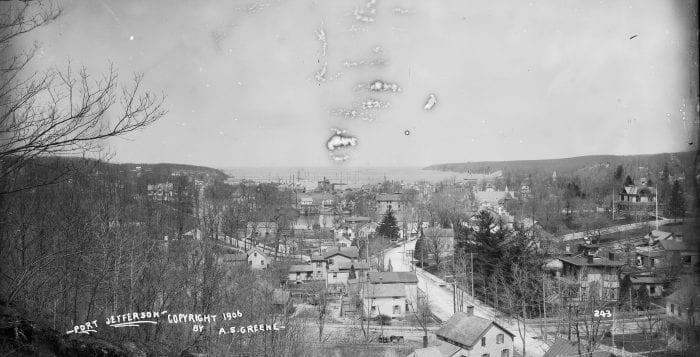
Time destroys all things. Photos fade, film degrades, buildings crumble. To stop entropy and the inevitable march of time, local historians, both local and regional, have been working to digitize a number of vintage Port Jefferson films and photos for more people to enjoy.
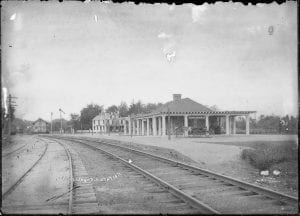
Cold Spring Harbor-based Preservation Long Island purchased a collection of glass slide photographs from renowned late 19th- and early 20th-century photographer Arthur S. Greene, who took photos from all over Brookhaven Town, many of which ended up on postcards and in books promoting Long Island as a tourist destination.
It wasn’t until 2018 that Preservation LI curator Lauren Brincat said the historical nonprofit was able to place the very delicate glass slides where people could see them. The Palmer School of Library and Information Science at Long Island University supplied Preservation with a grant as part of the school’s Digitizing Local History Sources project, funded by the Robert David Lion Gardiner Foundation. The grant brought two LIU students to Preservation’s headquarters to digitize the photographs.
Only one problem, there was no guide or template on how one should scan something as fragile as a glass slide. Brincat said the two LIU students had to start from scratch, creating their own guides and frames for photos of different sizes, 4×6, 5×7, etc. The group covered the flatbed with Mylar and used spacers to prevent the scanner from touching the artifacts.
It was a “tedious and labor-intensive” job, Brincat said, but the result is worth it. Hundreds of images are now stored online for anybody to peruse.

“There are great benefits to this,” the curator said. “It prevents having to go back to the original material, which could result in breaking them, emulsion or impact on the negative which are very light sensitive.”
The collection of photographs, Brincat said, captures the Island at a different time, especially how it developed from an agricultural, rural setting into its suburban commercial-based future.
“These pictures show the introduction of electricity and the automobile,” she said. “Many of the streets were dirt roads, which is hard to imagine today.”
Other people closer to home have also set themselves to the task of digitizing Port Jefferson history, items that have helped both village residents and historians understand their roots.
Chris Ryon, the Port Jefferson Village historian, has been working with Belle Terre historian John Hiz on numerous projects, including getting a number of donated film reels from the Childs family digitized. Ryon said Hiz was instrumental in negotiating that donation to the Port Jeff archive.
“I just wanted to make sure they were kept in the community,” he said.
A video of Belle Terre includes reels of pergolas, things that Hiz said he’s only seen in print. Without such items, he said, historians don’t have that tangible way to look back on the locals’ past.
“It makes things come to life,” he said. “Having access is the most important thing. There’s probably tons of materials stored in people’s attics or basements, but being able to have access is critical.”

The reels depict numerous scenes from 1928 through 1940, including of a woman in a fur coat burning leaves in Belle Terre, of parades, and even of a picnic in Montauk, among others. One reel even shows flooding in Port Jeff reminiscent of recent events from this year and last.
The reels were sent to a historical group in Chattanooga, which has digitized the reels at $15 a piece. The Port Jefferson Harbor Education & Arts Conservancy provided funds.
“It blew my mind once I first saw it,” Ryon said. “Everyone I showed it to had the same reaction — to see it come alive is another level, another dimension.”
The PJ historian is still waiting on five more reels to come back, which he expects will be in a few weeks. The videos are all being displayed in the public Facebook group Port Jefferson Maritime, though Ryon said he may look for some video to be posted to the Port Jefferson website.
“Once it becomes digitized, we can send it all over the world,” Ryon said. “Everyone who wants to can see it.”
Preserving History: County Site Falls into Disrepair Despite Funding
Instead of selling their property to a developer for nearly $2 million, the family of Walter S. Commerdinger, Jr. sold to Suffolk County in 2006 their property on the north side of Lake Ronkonkoma with its historic home, circa 1810, for a reported $1.2 million. The idea, said Commerdinger’s heir, Paul Albert, was to turn the site into a living museum to honor the legacy of the family, regarded as one of Nesconset’s earliest settlers.
The home, which was in pristine condition when sold, has sat vacant for more than a decade now and has been repeatedly vandalized. Despite being awarded $100,000 in grant money for repairs from the Robert David Lion Gardiner Foundation, the county has allegedly not yet followed through with its end of the bargain.
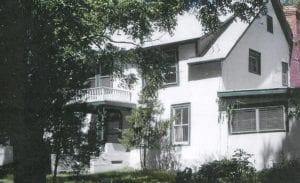
Both parties aim to renegotiate the agreement.
Marie Gruick is a member of Nesconset Chamber of Commerce and she’s been helping Albert navigate the situation he’s facing with the government.
“They keep saying they’re broke,” Gruick said. “It’s been a bunch of empty promises. They just gave other communities $500,000 for a parking lot.”
The situation, though, highlights the challenges of preserving history on Long Island and in New York in general. Commerdinger Park and Marion Carll Farm, in Commack, are two examples of families hoping to preserve history with gifts of historic homes and properties to public entities. Both sites have historic homes that have fallen into a state of disrepair.
Sara Kautz is the preservation director of Preservation Long Island. The not-for-profit organization works with Long Islanders to protect, preserve, and celebrate cultural heritage through advocacy, education, and stewardship of historic sites and collections. The organization offers many services for free. She said that more and more places are at risk.
John Kennedy Jr. (R) served as Nesconset’s county legislator in 2006 and helped facilitate the initial transaction for the Commerdinger site. Kennedy now serves as county comptroller and is running for county executive. His wife Leslie Kennedy (R-Nesconset) now serves as county legislator for District 12. She said there are no new updates.
“There’s a contract that everyone is reading through, so Commerdinger can join up with Smithtown Historical Society,” Leslie Kennedy said. “But it’s all in the talk stage.”
Gruick said the park is the last green space in Nesconset and its trails stretch to Lake Ronkonkoma. If the county isn’t interested in maintaining the home, she said, they should give it back. The family formed a 501(c)3 nonprofit, W.S. Commerdinger Jr. County Park Preservation Society, in 2008 to serve as stewards for the site but have been unable to accomplish what needs to be done for the house and its buildings. They say they feel like they’re on a merry-go-round.
“How long is the county going to dangle carrots,” Gruick said.
The most immediate task, Gruick and Albert said, is to get PSEGLI to hook up the electricity to the site, so they can install security cameras to prevent further damage and to get county water hookup. What Gruick doesn’t understand, she said, is why the county is telling them that hooking up to electricity needs to go to bid if PSEGLI is the business that connects electricity.
The county said in response to our inquiries that the order is in with PSEG, which needs to schedule the work. They could not provide a time frame for electric hookup and could only say that the request has been in for a while.
Albert said that he has collections of antiques, including pottery crafted in the first kiln brought to America. He had hoped to move the pieces into the site by now. Formerly a banker, Albert said that he needs a lawyer that specializes in preservation but is unsure who has that expertise.
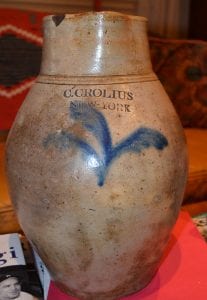
Kathryn Curran is the executive director of the Gardiner Foundation, a philanthropic group that supports historic preservation projects for 501(c)3 organizations with an education mission, but not for schools.
The foundation offers $5 million in grants annually and said that some projects go more smoothly than others. When a municipality owns a building, she said, they typically have a contract in place with a “friends” group to manage the property.
“The money is allocated to the friends group, not the municipality,” she said.
Because of the “friends” agreements with government, she said the group needs town approval for the work and the contracts it hopes to secure. For some reason, towns or government entities don’t always feel comfortable with the process.
“We’re trying to give historic educational experiences to enhance a community,” she said. “It’s a downtown revitalization gift.”
She said that local businesses benefit when these projects are completed, so she doesn’t always understand herself why governments are reluctant. She said that many people are willing to volunteer as part of a friends group. These people, she noted, are also a precious gift.
“It appears they don’t want to be beholden to private money,” she said.
Gruick and Albert said they are frustrated but remain hopeful. They plan to meet with officials in the Town of Smithtown in the upcoming weeks for help.
Enter the largest apple pie baking contest on Long Island
Time to bake a pie!
The humble apple will be the focus of the largest Apple Pie Baking Contest on Long Island to be held in conjunction with the 30th annual Long Island Apple Festival on Sunday, Sept. 29 at the Sherwood-Jayne Farm, 55 Old Post Road, Setauket from 11 a.m. to 4:30 p.m.
 Contestants will have the chance to show off their favorite family recipes and participate in an old-fashioned blue ribbon competition during the event, which is sponsored by Preservation Long Island and Homestead Arts.
Contestants will have the chance to show off their favorite family recipes and participate in an old-fashioned blue ribbon competition during the event, which is sponsored by Preservation Long Island and Homestead Arts.
Entries must be traditional apple pies only. The pie, including crust, must be homemade by amateur bakers. The registration deadline is Sept. 27. Pies must be on the contest table at the Sherwood-Jayne House by 10:30 a.m. on the day of the festival. A written recipe must be submitted with each entry including the name and address of the baker. Each contestant will receive one free Apple Festival entry. Judging will begin at 2 p.m. with prizes awarded between 3 and 4 p.m.
According to Darren St. George, director of Education and Public Programs at Preservation Long Island, this year’s contest will be judged by nine distinguished judges including Port Jefferson Village Mayor Margot Garant; Lisa Basini, founder of The Baking Coach Inc.; Chef Marc Anthony Bynum, restaurateur and owner of MB Concepts; Adam Devine, manager of Three Village Inn’s Mirabelle Restaurant & Tavern; Bernice Fehringer from Chocolate Works in Stony Brook; Chef Phil Morizio, chef and owner of Café Al Dente in Oyster Bay; Nick Acampora, president of Port Jefferson Historical Society; New York State Assemblyman Steve Englebright; and Town of Brookhaven Councilwoman Valerie M. Cartright plus one lucky apple festival guest who will be selected as an honorary judge.
First-, second- and third-place winners will be announced for Best Tasting Pie. A fourth winner will be chosen for Most Beautiful Pie. The first-place winner will be invited to be a judge at next year’s Apple Pie Baking Contest. All pies, including their dishes, will be auctioned off after the winners have been announced.
For contest entry forms, please visit www.preservationlongisland.org. For more information, call 631-692-4664.
Port Jeff historians decry potential loss of historic house
The vines inch up the side of the house at 49 Sheep Pasture Road. The grass was recently mowed, but only enough to keep the shrubs and the weeds from overtaking the lawn, and a unsecured Christmas tree light strand dangles from the front porch like a loose appendage. To the right-hand side of the one-acre property is a small, gazebo-like structure where old faded paintings cover the windows in flowers, hearts and what seems to be the names of children. Inside that structure, debris is strewn about, windows are broken and the back wall is caving in.

On Long Island, zombie homes like this are a dime a dozen tragedy, but local historians look at the home along Sheep Pasture and see an even greater misfortune, since the house has real historical significance, having been built in the pre-Revolutionary War period by the famous Tooker family, which gave the house its name.
“It’s one of the oldest homes still on its original location in the village,” said Nick Acampora, the president of the Port Jefferson Historical Society. “We have zombie problems with the Island, of course, and if it’s a house that was built later on, that has no historical value, people are quick, let’s get it out of here. When you have a 200-year-old building, it’s a little different.”
At a May 20 village board meeting, village officials voted to have the house at 49 Sheep Pasture Road demolished, citing the general state of the building and complaints of the residents.
At the May meeting, acting Chief of Code Enforcement Fred Leute helped present a number of pictures to those who attended the meeting. This included images of needles, used alcoholic bottles and other obvious signs of vagrancy.
The village has yet to put out bids for the demolition, and Mayor Margot Garant said the village has paused in any further action on the building while continuing to take care of the grass and state of the property, all the while hoping to see what may come out of trying to communicate with the property owner.
“I’m glad we’ve brought awareness to the property because it hasn’t been in good repair for 18 months,” Garant said. “If they can purchase it, that would be great.”
The largest issue at hand is the property is privately owned, and it does not exist on any current historic registries. The village has reached out to the current owners, Jericho-based Tab Suffolk Acquisitions LLC, with no success.
“I don’t think anybody’s been ignoring this, it’s just been a difficulty with the owner,” the historical society president said.
In the book “The Seven Hills of Port” by the late Robert Sisler and his wife Patricia, the house is referenced as “the only 18th century house still intact today in our village sitting in its original footprint on its original foundation,” being dated back to the 1740s.
In fact, the manner in which the book, written more than three decades ago, describes the house could not be any more distinct than how the home looks now. The book references Roman numerals on the attic rafters of hand-hewn post-and-beam construction. The building also contains a beehive domed oven in the fireplace and an old coat cellar in the east end of the building and an additional 20th-century modification to the living room for hiding liquor during the prohibition era, according to the book. Additional later modifications include added dormers and a porch. The book says even the original windows exist on the building’s north face.
“We do have a couple of houses from that time that have been moved, but this one is still on its original property,” said Catherine Quinlan, historical society trustee.
However, comparing then to now is staggering. A number of local residents who attended the May meeting asked for the building to be razed, saying they knew it had been broken into and used by vagrants in the past.
“To have a house from the 1700s, with this kind of context, is extraordinary.”
— Steve Englebright
State Assemblyman Steve Englebright (D-Setauket) said he had been in touch with both the village and historical society, adding the preservation of such a venerable home would be a top priority for him and his staff. He said there should be a chance to bring in a historical architect to verify the real historical nature of the location, and he would be working to identify funds necessary to take over the building from the current owners and creating stewardship over the building with a nonprofit.
“To have a house from the 1700s, with this kind of context, is extraordinary,” the assemblyman said.
Preservation Long Island, a nonprofit historical preservation organization, posted June 6 about the house to its Facebook page.
“Instead of a village-funded demolition, perhaps the village could fund an independent engineering assessment for a second opinion on the condition?” it reads. “Long Island’s oldest houses are surprisingly resilient thanks to old growth timber-frames and incredible craftsmanship.”
The mayor and other officials were hesitant to allow people into the building since she said the engineers who studied it had told her there was major structural defect in the building.
“We’re really concerned about people going into the premises and literally falling through the floor,” she said.
In the book, it references the owner as of 1992 when the book was written as Tony Chiarini, saying he was rewiring the house at the time.
Acampora said he understood the position the derelict property has put the village in, and only hopes that the historical society is contacted before the building is demolished or condemned in order for them to see if they can acquire any and all historical items from the house.
“They have to answer to the folks around it,” Acampora said.
Tour the Sherwood-Jayne House this weekend
Looking for something to do this Saturday? Why not take a step back in time and visit the historic Sherwood-Jayne House, 55 Old Post Road, East Setauket on Saturday, Oct. 6?
Preservation Long Island will offer docent-led tours between noon and 3 p.m. Originally built around 1730 as a lean-to salt box dwelling, the house and agricultural setting were maintained as an operational farmstead for over 150 years by members of the Jayne family. In 1908, Preservation Long Island’s founder, Howard C. Sherwood, acquired the property to showcase his lifetime interest in collecting, studying and living with antiques. The house contains period furnishings and features original late-eighteenth-century hand-painted floral wall frescoes.
Admission is $5 adults, $3 children ages 7 to 14. Tours are also offered by appointment. For more information, call 631-692-4664.




